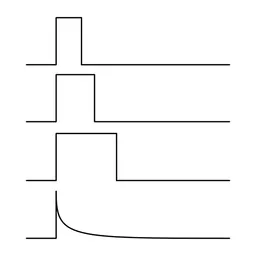Take note: a difference between gates and CV
Many of us are used to thinking of notes in a certain way: if we compose in a DAW, a note is a line on a piano roll, consisting of pitch and note duration. If we play a classical instrument, a note is a dot that shows us pitch and note duration. However, in Eurorack, there are two properties to a melodic “note”: gate, which tells us when a note starts, how long it exists, and when it stops; and pitch CV, which tells us the pitch (or technically, the voltage applied to the base pitch that modulates it). These are two separate signals, and that’s good, because it gives us more flexibility, but it can also be a little bit confusing. Let’s discuss.
A common question
One thing we are often asked is how we create a rest on a pitch/CV sequencer like Vox Digitalis or Mimetic Digitalis. The short answer is: we don’t! A rest is completely controlled by gate, so you need to create a rest in your gate sequence. The only thing the pitch sequencer needs to do is… well, nothing. A handy trick that I often use is to advance my pitch sequencer with whatever gate source is controlling my voice. For example, I can set Vox Digitalis to have as many steps as I want. If there are 7 gates in a looping sequence, I set it to have 7 steps, and then assign my notes from there. Mimetic Digitals simply requires a reset gate in to loop the number of steps I want it to loop (and strictly speaking Vox Digitalis can also work this way too!).
Learn more:
Is this good or bad?
While it takes a bit of getting used to, in my opinion, it’s a great thing! It gives us a lot more flexibility. Many sequencers combine gate and CV for us, but many don’t, so we can do even more with our sequences. Let’s take the above example and do something cool with it: I have a sequence that’s 7 gates long. That’s going to get pretty repetitive pretty fast. But what if instead of setting VD to also have 7 steps, I set it to have 8? It would then loop in a different meter from my gates and we have instant variation and musical interest. There are lots and lots of different creative ways to make sequences more interesting when we think about gates and CV separately, which is why I think this property of Eurorack is so great.
Lets see
Here, we’re using Bin Seq to create a trigger sequence, and running both our voice module, Cursus Iteritas Percido, and Vox Digitalis off of the triggers it creates. We’re also resetting both BS and VD with the same trigger to keep them both in sync when we change up the trigger patterns. Simple but fun!
Get creative
This was a short, but in my opinion, important post. Hopefully, you’re on your way to thinking about creative patches you can make now that we’ve separated our note properties and can patch without limits! The world is your oyster! Who came up with that phrase anyway?






